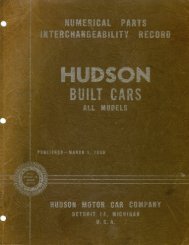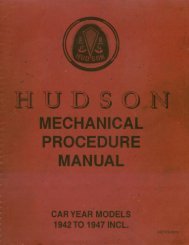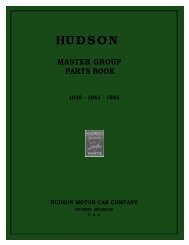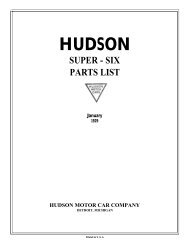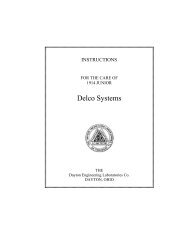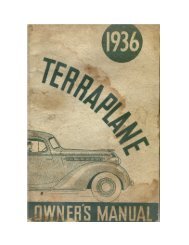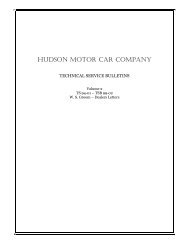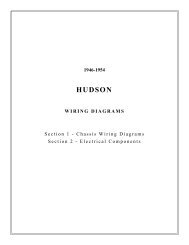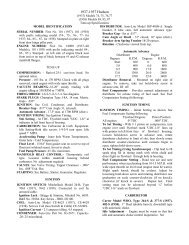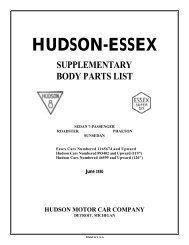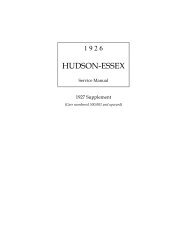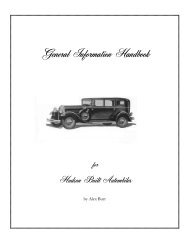1948-1952 Shop Service Manual - - Hudson-Essex-Terraplane Club
1948-1952 Shop Service Manual - - Hudson-Essex-Terraplane Club
1948-1952 Shop Service Manual - - Hudson-Essex-Terraplane Club
Create successful ePaper yourself
Turn your PDF publications into a flip-book with our unique Google optimized e-Paper software.
15 - 8 BRAKES<br />
Fluid withdrawn in any bleeding operation should not<br />
be used again.<br />
Replenish fluid in the master cylinder after each cylinder<br />
isbled. If filler bottle J-713-C (filler and threaded adapter) is<br />
used, this constant check on the master cylinder is not<br />
necessary because of its large capacity and the fact that the<br />
quantity is easily watched.<br />
If the master cylinder is drained during the bleeding<br />
operation, air will enter the system and the bleeding will<br />
have to be done all over again at all four wheels.<br />
When bleeding operation is completed the master cylinder<br />
must be refilled.<br />
Check fluid level in master cylinder every 1000 miles.<br />
BRAKE FLUID<br />
Hydraulic brake fluid must have a high boiling point to<br />
prevent evaporation and to prevent any tendency to vapor<br />
lock, yet at the same time a good brake fluid must remain<br />
fluid at cold temperatures.<br />
There are some types of brake fluid that are composed of<br />
ethyl alcohol and castor oil; cellosolve and castor oil; alcohol,<br />
water, and glucose with some chromate added to retard<br />
corrosion; mineral oil; anti -freeze alcohols with no castor<br />
oil added.<br />
Brake fluids of the above types are all harmful because -<br />
Ethyl alcohol has a lower boiling point than HUDSON<br />
BRAKE FLUID, causing it to vaporize more rapidly and<br />
increasing the tendency to produce a vapor lock in the lines.<br />
Cellosolve has a rather severe action on rubber parts and<br />
should not be used for that reason.<br />
Water and glucose is worthless as water will corrode the<br />
metal parts of the system and glucose forms a sticky mass<br />
when exposed to air and has no lubricating qualities.<br />
Mineral oil, in even the smallest quantity, should never<br />
be used. The slightest trace of mineral oil will destroy the<br />
sealing qualities of the two rubber piston cups in two or<br />
three days. Never wash any hydraulic brake parts in gasoline<br />
as even the slightest amount of mineral oil present in<br />
gasoline will affect the rubber parts.<br />
<strong>Hudson</strong> Brake Fluid mixes with other brake fluids<br />
recommended by automobile manufacturers. However, do<br />
not mix <strong>Hudson</strong> Brake Fluid with any fluids containing<br />
glycerine, sugar, glucose, mineral oil or water.<br />
ADJUSTMENT<br />
HAND BRAKE LEVER<br />
ADJUSTMENT<br />
With the hand brake fully released, the brake cables<br />
should permit the anchor ends of the rear brake shoes to rest<br />
on the anchor pin; if not readjust as follows:<br />
Pull hand brake grip two notches from full release. There<br />
should be 1/8" clearance between the hand brake cable lever<br />
(5) and end of slot in lever guide plate (24). If not - adjust<br />
hand brake cable clevis (51) until 1/8" clearance is obtained.<br />
Pull rear brake cables (6) tight adjust clevises so that clevis<br />
pins just enter holes in toggle (35). All slack should be<br />
removed when clevis pins are in place and hand brake<br />
applied two notches.<br />
Check engagement of hand brake ratchet rod lock springs.<br />
Replace worn or broken springs.<br />
BRAKE PEDAL ADJUSTMENT<br />
The brake pedal lever (8) Figure 1 should have between<br />
1/4" to 3/8" free play; this free play is the movement of the<br />
pedal lever (8) before the master cylinder push rod touches<br />
the master cylinder piston.<br />
This adjustment is important to assure that the master<br />
cylinder piston returns to its normal position, otherwise the<br />
brakes will drag.



